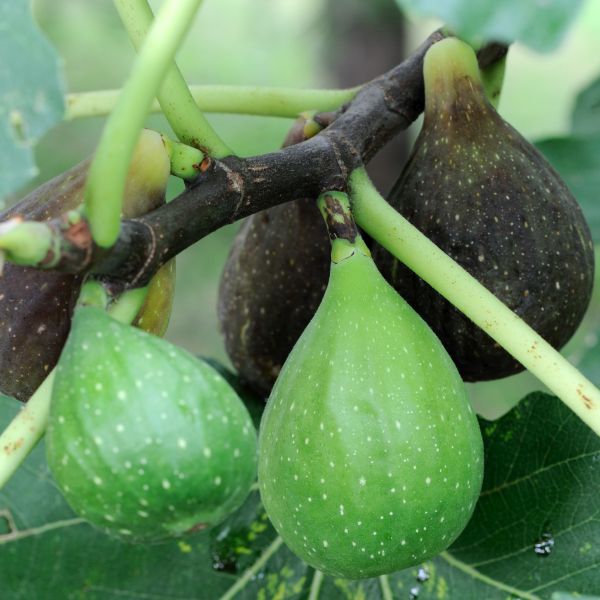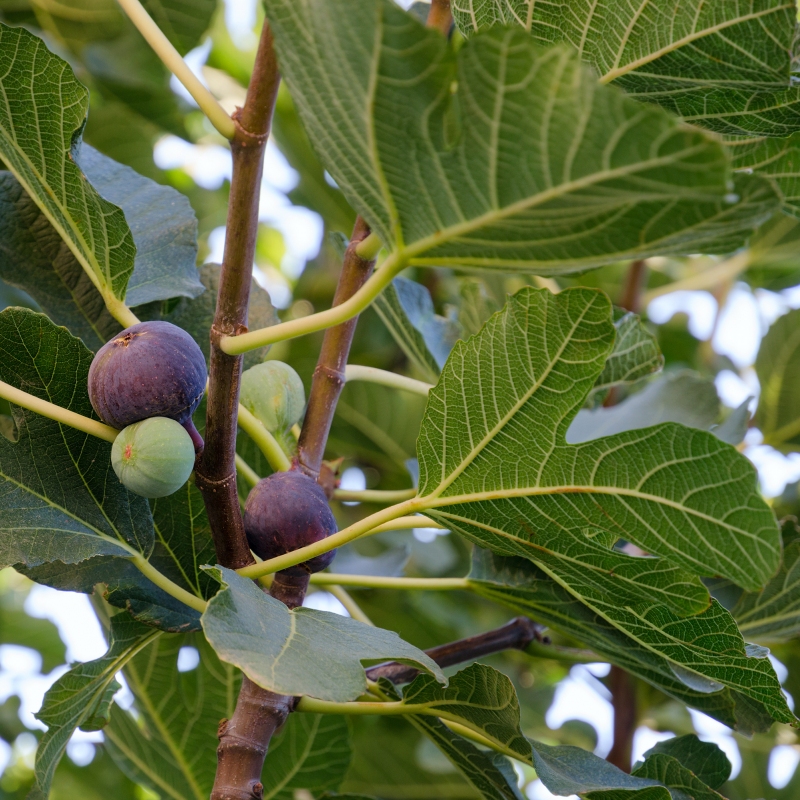



Celeste Fig
Ficus carica Celeste
92 reviews
Celeste Fig
Ficus carica Celeste
92 reviews
- Naturally sweet and delicious flavor
- Packed with essential vitamins and nutrients
- Versatile ingredient for both sweet and savory dishes
- Recommended by landscape designers for optimal fit in real yards
$112.00
$160.00
30% Off
- Ships to in 3-5 Days
- Free Shipping Over $150
- Plant Arrival Guarantee
- In Stock
- Free Plant Consult
$200 - Landscape-Approved: Every Plant We Sell Comes With Design Expertise Behind It
Trade 3 Gallon
We are sorry, product is currently out of stock due to seasonal availability. Please check the "Related plants available in your area" section below
Not just beautiful - intentionally selected by ShrubHub's 3D landscape design team to fit real-world spaces and maximize yard potential.
Why Celeste Fig?
Celeste Fig, also known as Ficus carica Celeste, is a popular variety of fig tree known for its sweet, dark purple fruit with a rich, honey-like flavor. This self-pollinating tree can grow up to 10 feet tall and is prized for its ability to produce fruit in cooler climates. Celeste figs are delicious when eaten fresh or used in cooking and baking recipes.
Sunlight
Celeste Fig trees need full sun to thrive and produce fruit. They should be planted in a location that receives at least 6-8 hours of sunlight per day. Adequate sunlight is essential for healthy growth and optimal fruit production.
Watering
Celeste Fig trees have moderate watering needs, requiring regular deep watering to keep the soil consistently moist but not waterlogged. During hot weather or drought conditions, they may need more frequent irrigation. It is important to allow the soil to
Fertilizing
Celeste Fig trees benefit from a balanced fertilizer such as a 10-10-10 blend in the spring and summer months. Fertilizer should be applied about 6 inches away from the tree trunk to avoid burning the roots. It is important to follow the manufacturer's ins
Celeste Fig (Ficus carica Celeste)
The Celeste Fig, also known as Ficus carica Celeste, is a variety of fig tree known for its delicious, sweet figs. This tree is a popular choice for home gardeners due to its compact size and ease of care.
The Celeste Fig tree typically produces small to medium-sized fruit with a light brown to purple skin when ripe. The flesh is sweet, juicy, and has a honey-like flavor that is highly regarded by fig enthusiasts.
These fig trees are self-pollinating, making them an excellent choice for those with limited garden space. They can be grown in containers or in the ground, and prefer full sun and well-drained soil.
Celeste Figs are known for their cold-hardiness, making them suitable for growing in a wide range of climates. They are also relatively resistant to pests and diseases, making them a low-maintenance fruit tree option for novice gardeners.
Whether enjoyed fresh off the tree, in desserts, or preserved into jams and spreads, the Celeste Fig is a versatile and tasty addition to any garden.
Plant Information:
| Botanical Name: | Ficus carica Celeste |
| USDA Zones: | 6 - 9 |
| Mature Height: | 10 ft |





Pollination Info
Celeste Fig Pollination Info
The Celeste fig is a self-pollinating variety, which means that it does not require another fig tree for pollination. However, having multiple fig trees nearby can increase the chances of fruit production through cross-pollination.
Figs are unique in that their flowers are actually inverted, with the tiny flowers located inside the fruit. In order for the figs to develop, they need to be pollinated by fig wasps. The female wasp enters the fig through a small opening called the ostiole and lays her eggs inside the flower. In the process, the wasp inadvertently pollinates the flower, allowing the fruit to develop.
Celeste figs can also be pollinated by wind and other insects that may carry pollen from one fig tree to another. It is recommended to plant multiple fig trees in close proximity to each other to encourage better fruit production through cross-pollination.
FAQ
Frequently Asked Questions About Celeste Fig Trees (Ficus carica Celeste)
1. What is a Celeste Fig tree?
A Celeste Fig tree, also known as Ficus carica Celeste, is a type of fig tree that produces small to medium-sized sweet and flavorful figs. These trees are popular among home gardeners for their ease of care and delicious fruit.
2. How do I plant a Celeste Fig tree?
Celeste Fig trees prefer well-draining soil and full sun. Choose a location with plenty of sunlight and space for the tree to grow. Dig a hole twice as wide and deep as the root ball, place the tree in the hole, and backfill with soil. Water the tree thoroughly after planting.
3. How often should I water my Celeste Fig tree?
Water your Celeste Fig tree regularly, especially during hot, dry weather. Water deeply at the base of the tree, making sure the soil is moist but not waterlogged. Reduce watering in the winter months when the tree is dormant.
4. When is the best time to harvest Celeste Figs?
Celeste Figs are typically ready to harvest in late summer to early fall. The figs should be slightly soft to the touch and have a rich color when ripe. Simply twist the figs off the tree or use scissors to cut them from the stem.
5. How do I prune a Celeste Fig tree?
Prune your Celeste Fig tree in late winter or early spring to remove any dead or damaged branches and promote new growth. You can also prune to shape the tree and improve air circulation. Avoid heavy pruning, as it can reduce fruit production.
6. Do Celeste Fig trees need fertilizer?
Celeste Fig trees benefit from a balanced fertilizer in the spring, just before new growth begins. Use a slow-release fertilizer or compost to provide the tree with essential nutrients for healthy growth and fruit production.
7. Are Celeste Figs self-pollinating?
Yes, Celeste Fig trees are self-pollinating, meaning they do not require a second tree for pollination. However, having multiple fig trees nearby can increase fruit production and quality.
8. What pests and diseases affect Celeste Fig trees?
Celeste Fig trees are relatively resistant to pests and diseases, but they can be susceptible to fig mosaic virus, root knot nematodes, and fig rust. Proper care, including regular pruning and watering, can help prevent and manage these issues.
Planting & Care
Celeste Fig (Ficus carica Celeste) - Planting & Care Guide
Planting:
1. Choose a sunny location with well-draining soil for planting your Celeste fig tree.
2. Dig a hole twice as wide and just as deep as the root ball of the tree.
3. Place the tree in the center of the hole and backfill with soil, gently tamping down to remove air pockets.
4. Water the tree thoroughly after planting to help it establish its roots.
Care:
1. Watering: Keep the soil around the tree consistently moist, especially during hot and dry periods. Water deeply but infrequently to prevent waterlogged soil.
2. Fertilizing: Feed your Celeste fig tree with a balanced fertilizer in early spring and midsummer to promote healthy growth and fruit production.
3. Pruning: Prune the tree in late winter to remove dead or diseased branches and to shape the tree for optimal growth.
4. Mulching: Apply a layer of mulch around the base of the tree to retain moisture and suppress weeds.
5. Protection: Protect the tree from extreme cold temperatures by covering it with a blanket or burlap during frosty nights.
Harvesting:
Harvest Celeste figs when they are soft to the touch and have a deep purple color. Twist the fruit gently to detach it from the tree.
Pests & Diseases:
Common pests that may affect Celeste fig trees include fig beetle, scale insects, and spider mites. Keep an eye out for signs of infestations and treat them promptly with insecticidal soap or neem oil.
Leaf spot, rust, and root rot are some common diseases that can affect Celeste fig trees. Prevent these diseases by providing good air circulation and avoiding overwatering.
By following these planting and care guidelines, you can enjoy a bountiful harvest of delicious Celeste figs from your tree!
Check Out These Verified Customer Reviews:
Customer Reviews
4.7 out of 5 based on 92 reviews
Thank you! Your review has been submitted.
Figs were ripe and delicious.
The Ficus Fig 'Celeste' arrived in perfect condition! It looks beautiful and healthy.
I can't believe how quickly my Ficus Fig 'Celeste' arrived. It's in great condition and thriving already.
Item has been added to your cart.


